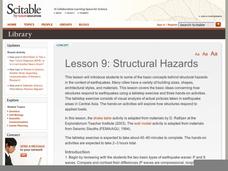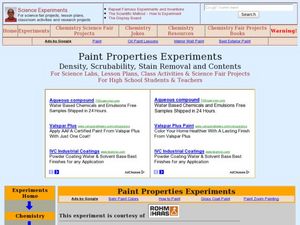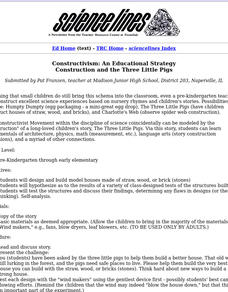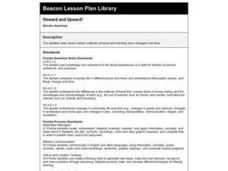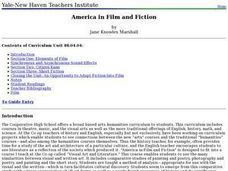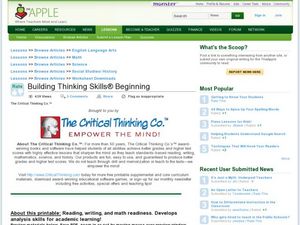Nature
Structural Hazards
The scientific explanation of seismic waves is detailed in the introduction. A fictional scenario is also provided for your class to discuss. Pictures and handouts that are meant to be included, however, they are not accessible....
Ms. Amber Nakamura's Mathematics Website
Algebra Project
What would your dream house look like? A cottage? A medieval castle? High schoolers enrolled in Algebra design the perfect house while using slopes to write equations for various aspects of the project.
Curated OER
Immigration Unit
Third graders develop an appreciate for the various cultures that are present in their local community. Through reading and research, they explain how various culture came to live in their area. At the conclusion of the unit, 3rd...
Curated OER
Art of Cynicism
High schoolers analyze selected pieces of art and infer how they reflect a sense of disillusionment, and/or cynicism in American society in the aftermath of the Vietnam War and Watergate scandal. Then they identify and place cultural...
Curated OER
Rationalizing Race in US History
Students consider the classification of people. For this race studies lesson, students examine the concept of race as it relates to U.S. history and trends. Students research racial discrimination and prejudice in order to support their...
Curated OER
Reformation Lesson: Worship and Belief
Students explore the characteristics of different religions and religious beliefs. In this World History lesson, students research the history of the Reformed, Catholics and Lutherans, then complete several activities to reinforce...
Curated OER
The Golden Ratio
Seventh graders investigate a ratio found in nature and in numerous pieces of artwork throughout history. The lesson is cross-curricular and builds a sense of appreciation of design for students.
Curated OER
Numbers in Art
Students choose a number from one to twelve and tell a number story about it. They listen to the teacher read "Numbers in Art" by Lucy Micklethwait. Students choose three numbers from one to twelve and view works of art while looking for...
Curated OER
Introduction And Brief History of Materials Science
Students develop an understanding of the concept of matter. They l participate actively in the bubble raft experiment as described on the Center for Thermal Spray Research's website. They demonstrate dislocations and grain...
Curated OER
Frosty the Snowman Meets His Demise: An Analogy to Carbon Dating
Learners read and discuss an article about carbon dating, then participate in a hands-on lab to discover how carbon dating works. Students also write a letter to a friend explaining the process, and how archeologists use the process to...
Curated OER
It's Greek to Me!
Students explore Greek Mythology. In this Greek Mythology unit, students read myths, pantomime vocabulary words, practice research skills, create city-states, and demonstrate knowledge of ratios and proportions. This unit includes many...
Curated OER
Basics of Archaeology
Young scholars identify what and how to complete an Archaeological excavation is conducted. They identify the transition from one layer to the next more easily if the colors of the layers are different. When creating a dig, the teacher...
Curated OER
China's Giant Panda
Third graders read an article called "All About Pandas." In this Panda lesson, students become familiar with the connection of the Panda to Chinese culture. Students recognize that Pandas are endangered. Students complete a...
Curated OER
Ancient Roman Monuments and Timeline
While a terrific idea, this lesson in which learners create a timeline showing the date that a variety of buildings and monuments were built in Ancient Rome, requires resources teachers may not have. It requires the use of a Smartboard,...
Curated OER
Quantitative Determination of the Composition of Water-based Paints and the Correlation of Paint Properties to Pain Composition
High schoolers perform a series of tests on water-based paints. In this chemistry lesson, students identify their different functions. They calculate paint density and fractional concentrations.
Curated OER
The Acoustics House
Students study how drums produce sound by building and playing a simple drum. They measure the diameter of their can, then mark a circle two inches larger in diameter on their piece of plastic with the marker or chalk, and cut out the...
Curated OER
Turin, Geography, Culture And Sports
Students study why certain locations are suitable to host the Winter Olympics. They research the characteristics of Turin, Italy, plan a trip and create a multimedia scrapbook of the trip.
Curated OER
Construction and the Three Little Pigs
Students construct science experiments based on nursery rhymes and student stories, including: Humpty Dumpty, the Three Little Pigs and Charlotte's Web.
Curated OER
Documenting History: Photographs as Social Commentaries
Young scholars examine photographs that make social statements. They examine content, symbolism, and their personal reactions to works of art that make expressive statements about social issues.
Curated OER
America in Film and Fiction
Learners begin the lesson by reading a book on film study. After watching the movie "Citizen Kane", they work together to identify the issues concerning the United States before World War II. As a class, they discuss how the ideas and...
Curated OER
Where Do I Live?
Students study the characteristics of communities. Students identify similarities and differences in communities. Students identify that all people have basic needs, understanding that these needs are met through the community. Students...
Curated OER
Playing Historical Detective: Great Grandmother's Dress and Other Clues to the Life and Times of Annie Steel
Learners draw conclusions about an mystery person based on documents and artifacts provided. In this drawing conclusions lesson, students become detectives by reading and analyzing evidence provided. This lesson includes information on...
Curated OER
Thinking Skills: Connecting shapes
In this thinking skills worksheet, students draw a line connecting each blue figure without touching any other color. Students connect 4 figures.
